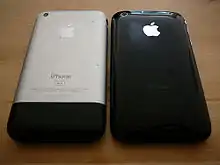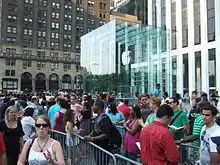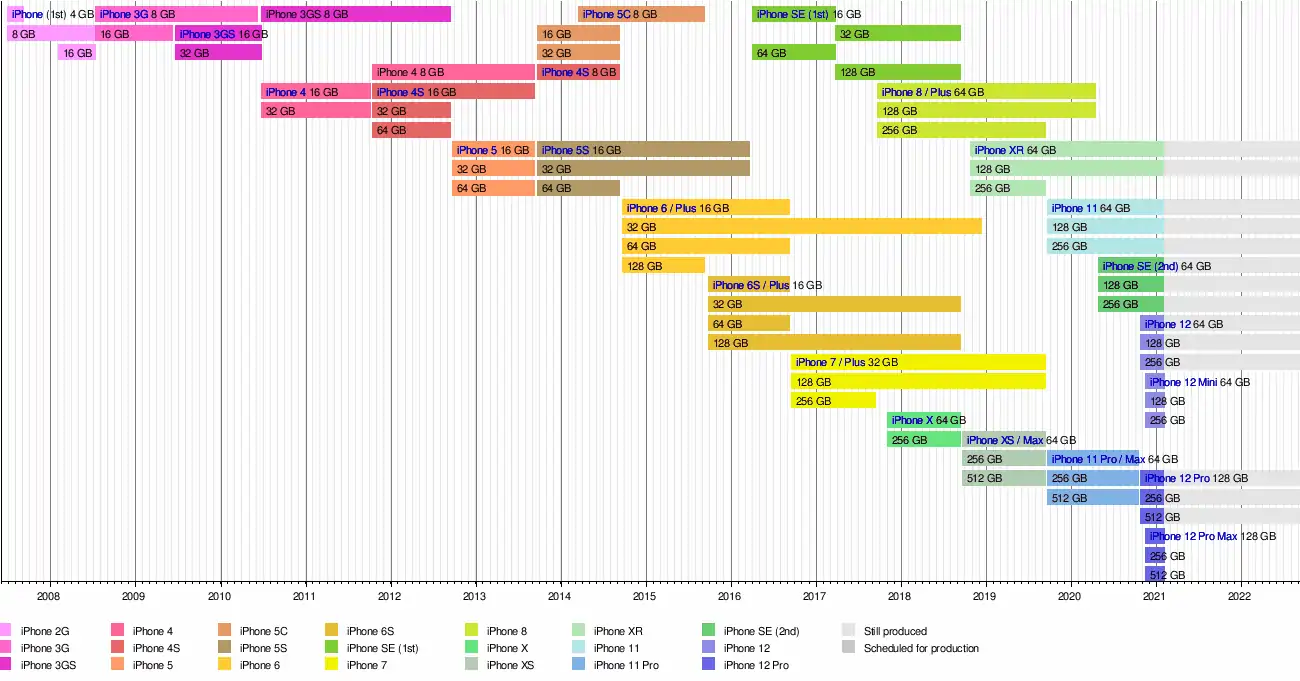iPhone 3G
The iPhone 3G is a smartphone designed and marketed by Apple Inc.; it is the second generation of iPhone, successor to the original iPhone, and was introduced on June 9, 2008, at the WWDC 2008 at the Moscone Center in San Francisco, United States.
| Developer | Apple Inc. |
|---|---|
| Manufacturer | Foxconn[1] |
| Slogan | "The iPhone you have been waiting for." "The first phone to beat the iPhone." "Twice as fast, for half the price." "The most advanced mobile OS. Now even more advanced." "New features, new price." |
| Generation | 2nd |
| Model | A1324 (China) A1241[2] |
| First released | July 11, 2008[3] |
| Discontinued | June 7, 2010 |
| Units sold | 1 million over first weekend[4] |
| Predecessor | iPhone (1st generation) |
| Successor | iPhone 3GS |
| Related | iPod Touch (2nd generation) |
| Type | Smartphone |
| Form factor | Slate |
| Dimensions | 115.5 mm (4.55 in) H 62.1 mm (2.44 in) W 12.3 mm (0.48 in) D |
| Mass | 133 g (4.7 oz) |
| Operating system | Original: iPhone OS 2.0 Last: iOS 4.2.1, released November 22, 2010 |
| CPU | Samsung 32-bit RISC ARM 1176JZ(F)-S v1.0[5] 620 MHz Underclocked to 412 MHz[6] |
| Memory | 128 MB DRAM[7] |
| Storage | 8 or 16 GB flash memory |
| Battery | 1150 mAh, 3.7 V Lithium-ion battery[8] |
| Data inputs | Multi-touch touchscreen display 3-axis accelerometer Proximity sensor Ambient light sensor Microphone Headset controls |
| Display | 3.5-inch screen (diagonally) 480×320 pixel resolution at 163 ppi 2:3 aspect ratio 18-bit (262,144-color) LCD |
| Rear camera | 2.0 MP with geotagging |
| Sound | 3.5 mm TRRS One speaker 20 Hz to 20 kHz frequency response (internal, headset) Microphone |
| Connectivity | Quad-band GSM/GPRS/EDGE (850 900 1,800 1,900 MHz) Tri-band UMTS/HSDPA 3.6 (850 1,900 2,100 MHz) Wi-Fi (802.11 b/g) Bluetooth 2.0 + EDR USB 2.0/Dock connector[9] Online: App Store, iTunes Store, iBookstore, MobileMe |
| Website | Apple - iPhone at the Wayback Machine (archived July 23, 2008) |
| This article is part of a series on the |
| iPhone |
|---|
| List of iPhone models |
The iPhone 3G is internally similar to its predecessor, but included several new hardware features, such as GPS, 3G data and tri-band UMTS/HSDPA. The device was originally loaded with the concurrently launched iPhone OS 2.0. In addition to other features (including push email and turn-by-turn navigation), this new operating system introduced the App Store—Apple's new distribution platform for third-party applications.[10]
History
On July 11, 2008, Apple released the iPhone 3G across twenty-two countries in two storage options, 8GB and 16GB.[11] The 16GB model was produced in either black or white.[12][13] It was sold for a suggested retail price of $199 (US) for the 8GB model and $299 (US) for the 16GB model.[10]
Following the release of the successor iPhone 3GS model one year later, the iPhone 3G remained on sale but became Apple's budget phone offer, with its price reduced. This $99 iPhone 3G required a two-year contract and was available only in black and with 8 GB of storage, but came bundled with the then-new iPhone OS 3.0 firmware.[14] On June 7, 2010, the iPhone 3G was finally discontinued, and replaced as Apple's budget phone by an 8GB iPhone 3GS selling for the same price of $99 with a 2-year contract.
Software
The iPhone 3G came preloaded with the latest version of iOS and continued to receive updates to its software for over two years, with major iterations released on an annual basis. However, the phone had access to a decreasing proportion of new features with each update as its hardware became superseded by later models.
When it was launched, the iPhone 3G came preloaded with iPhone OS 2.0. This introduced the App Store, Microsoft Exchange ActiveSync support, Apple's MobileMe service, and push email support, along with other new features and bug fixes.
In June 2009, iPhone 3G users received the iPhone OS 3.0 software update, which introduced the long-awaited MMS feature, copy and paste, landscape support for more applications, Bluetooth stereo support, and other improvements.

In June 2010, Apple released the iOS 4.0 software update. Unlike its successor models, the iPhone 3G does not support prominent features of iOS 4.0 such as multitasking, the ability to set a home screen wallpaper, or Bluetooth keyboard support. However, it does provide access to a unified mailbox feature, homescreen folders to better organize apps, playlist creation, and other enhancements. This update was widely criticized for slow performance on iPhone 3G, though September 2010's iOS 4.1 release resolved this problem. However, unlike more modern iOS devices, this update again does not provide iPhone 3G owners with access to important features, in this case, the Game Center application.[15]
On November 22, 2010, the iPhone 3G received the iOS 4.2 software update (as iOS 4.2.1), which introduced features such as YouTube voting, and security fixes. However, the iPhone 3G is unable to use many features included in this update, such as AirPlay and Safari Text Search. This is the last iOS release to support this iPhone model; iOS 4.3 and later are not compatible with this iPhone model due to hardware limitations and performance issues.[16]
Virtually all apps released after the release of iOS 6 in late September 2012 do not run on the iPhone 3G, as the software development kit (SDK) was changed to no longer allow the "targeting" (minimum) of iOS versions older than 4.3 (including 3.x and up to 4.2.1), or ARMv6 devices (first two generations).
Hardware
Design

The iPhone 3G's back featured a redesigned polycarbonate plastic housing, replacing the aluminum back of the first generation. Buttons were changed from plastic to metal, and the edges of the phone were tapered, providing a better grip. The iPhone 3G introduced the first official color options for the outer casing, with the 16GB version available in black and white.
The dimensions of the iPhone 3G were marginally larger than those of the original iPhone. It was 116 millimetres (4.6 in) high, 62 millimetres (2.4 in) wide, and 12 millimetres (0.47 in) deep, compared to its predecessor, which was 110 millimetres (4.3 in) high, 61 millimetres (2.4 in) wide, and 12 millimetres (0.47 in) deep.
The iPhone 3G sported a 3.5 in (89 mm) capacitive touchscreen with a 480×320 (HVGA) resolution at 163 ppi. The scratch-resistant glass sits on top of the display. Just like the original iPhone, the touchscreen was designed for a bare finger, or multiple fingers for multi-touch sensing. The device featured the same sensors as its predecessor. The proximity sensor (which deactivates the display during calls when the face is near) was repositioned to save battery power and to prevent inadvertent inputs from the user's face and ears. An ambient light sensor was included to adjust the display brightness for different lighting conditions, which helps save battery power. A 3-axis accelerometer was included to sense the orientation of the phone and change the screen accordingly, allowing the user to easily switch between portrait and landscape mode.
Processor and memory
Most of the iPhone 3G's internal hardware is based on the original iPhone. It still includes a Samsung 32-bit RISC ARM11 620 MHz processor (underclocked to 412 MHz), a PowerVR MBX Lite 3D GPU, and 128 MB of package on package (PoP) DRAM.
Rear camera
On the rear of the device, the iPhone 3G features the same fixed-focus 2.0 megapixel camera of its predecessor. This camera does not have optical zoom, flash, autofocus, or native video recording, although various applications became available to allow video recording on the device. The iPhone 3G's operating system supports the geotagging of photographs.
Connectivity
In addition to EDGE, the iPhone 3G supports Assisted GPS, 3G data, and tri-band UMTS/HSDPA. These enhancements allow faster data downloads and turn-by-turn navigation with maps compared to previous devices.
Like its predecessor, the iPhone 3G features a proprietary 30-pin dock connector for charging the device. It can also be used to synchronize the device with a computer and to connect various accessories.
The iPhone 3G features a flush-mounted 3.5 mm headphone jack instead of the recessed headphone jack that was included on the original iPhone; it could, therefore, be used with any headphones other than those provided by Apple.
Battery
The iPhone 3G features an internal rechargeable battery rated at 1150 mAh, which, like its predecessor, is not user-replaceable. Apple stated that the iPhone 3G's battery is capable of providing up to six hours of web browsing via Wi-Fi, or five hours via 3G, or 25 hours of audio playback. Alternatively, it is said to provide 300 hours of standby time.
Reception

Walt Mossberg of The Wall Street Journal described the device as "a more capable version of an already excellent device." However, he said that it had "hidden costs."[18]
References
- Dalrymple, Jim (July 28, 2009). "iPhone manufacturer to pay family of dead worker". CNET. Retrieved April 6, 2010.
- Identifying iPhone models. Support.apple.com (April 8, 2013). Retrieved on July 10, 2013.
- Robert Palmer (June 8, 2008). "iPhone 3G announced — The Unofficial Apple Weblog (TUAW)". Archived from the original on January 31, 2015. Retrieved June 10, 2008.
- "Apple Sells One Million iPhone 3Gs in First Weekend" (Press release). Apple Inc. July 14, 2008. Retrieved November 10, 2017.
- Patterson, Blake (July 7, 2008). "Under the Hood: The iPhone's Gaming Mettle". touchArcade. Retrieved March 20, 2009.
- Dilger, Daniel Eran (March 20, 2008). "iPhone 2.0 SDK: Video Games to Rival Nintendo DS, Sony PSP". RoughlyDrafted Magazine. Archived from the original on May 16, 2009. Retrieved May 12, 2009.
- "Apple (Samsung S5L8900) applications processor with eDRAM". SUBM TechInsights. Archived from the original on July 15, 2010.
- "iPod and iPhone Battery and Power Specifications". iPodBatteryFAQ.com. Archived from the original on February 7, 2009. Retrieved May 12, 2009.
- "Apple — iPhone — Tech Specs". Apple; Wayback machine. July 14, 2007. Archived from the original on July 14, 2007. Retrieved January 19, 2009.
- "Apple Introduces the New iPhone 3G" (Press release). Apple Inc. June 9, 2008. Retrieved November 10, 2017.
- "Difference Between 8Gb & 16Gb on a 3G iPhone". Retrieved 2017-12-30.
- Costello, Sam. "Initial iPhone 3G Country Availability List". about.com. Retrieved January 11, 2009.
- "iPhone 3G Coming to countries everywhere". Apple Inc. Archived from the original on July 21, 2008. Retrieved April 12, 2009.
- Sandoval, Luis. "iPhone 3G only $99, it's Possible". crenk.com. Archived from the original on 2012-06-06.
- iPhone 3G Speed Test: iOS 4.0 versus iOS 4.1
- Gurman, Mark. "iOS 4.3 drops iPhone 3G and iPod touch 2G support". 9to5mac. Retrieved January 13, 2011.
- Whittle, Stephanie (Jan 25, 2014). "The Original iPhone 3G Was Built Out of Seemingly Stronger than Aluminum Plastic". EZ Buys Direct. Archived from the original on February 2, 2014. Retrieved Jan 25, 2014.
- Mossberg, Walter S. (2008-07-10). "Newer, Faster, Cheaper iPhone 3G". Wall Street Journal. ISSN 0099-9660. Retrieved 2017-01-03.
- Valentino-DeVries, Jennifer (July 28, 2010). "Apple Probes Complaints About iOS4 on iPhone 3G". The Wall Street Journal.
- Apple Inc. (2007–2020). iPhone News - Newsroom Archive. Retrieved July 23, 2020.

